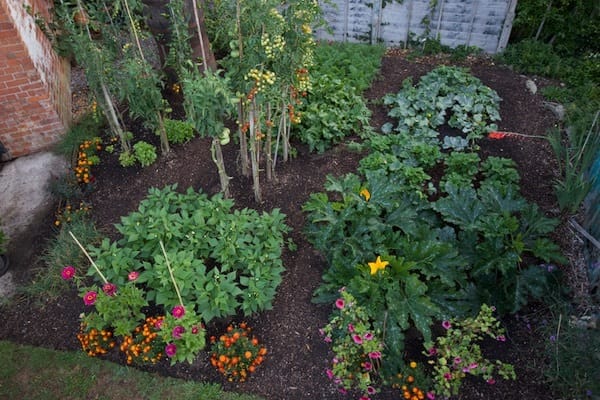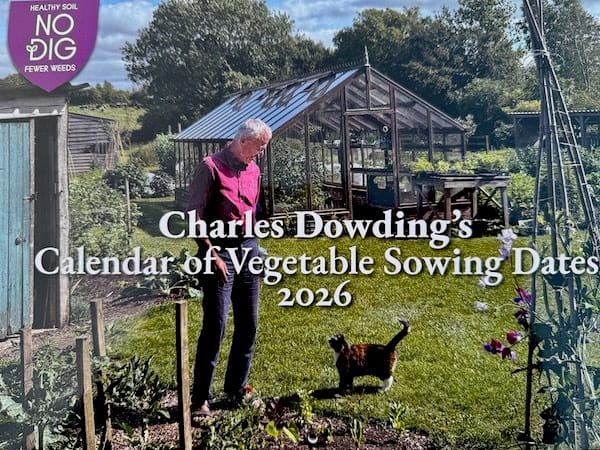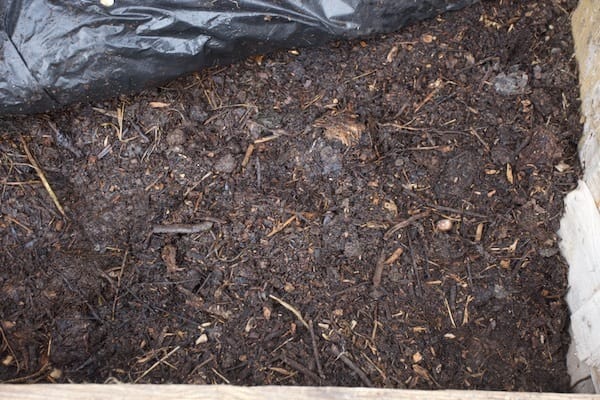
Much to play for
News and advice from Charles to you

Watering is every 3-4 days with a hose. The 25 m² / 270 ft.²‘small garden’ has cropped 62 kg / 136 lb this year.The far end needs extra water because of neighbouring trees rooting under the fence. Far left is a new vertical garden, see next photo.
From now, growth slows. Time spent sowing and planting in the next two weeks is your best investment in having healthy food during the next eight months.
Rainfall here since February is 60% down from the average. Systematic watering is a new thing for me, and results are excellent thanks to extra sunshine.
A water question
Q If I had the budget, I’d capture all rain and domestic brown water into an underground water tank for summer watering via an automated drip capillary system.
A The cost of any major water installation puts me off. Such as big tanks with pumps, or a borehole, plus all the plastic pipes needed for irrigation.
In three months this year from 10th April, during dry and very sunny conditions, growing a lot of salad leaves, my gardens used 192 m³ water.
The cost is around £260, from Bristol Water. During this time, I sold £12,000 worth of vegetables and grew a lot for autumn. All with the convenience of pressurised water at any time, which I easily improve with a Magnostream device. Enter NODIG at checkout for 10% discount.

14th August, small garden. An option for small spaces and water conservation, we filled these two whiskey barrels with 1/3 soil and 2/3 compost of different types, then planted with small seedlings one week ago, and have watered very little.
The barrels above are from Gardenscapes Uprooted in Yorkshire.
See this and more at our Open Day on Saturday 6th September. We are selling tickets (£14) to raise money for two great charities, Ripple Effect and Promise Works.

Mid-August. Teepees are for harvests of dry beans, borlotti and white Czar. Zinnias are my favourite summer flower.
Harvests and new plantings
Top seasonal vegetables now are tomatoes, cucumbers, sweetcorn, green beans, chard, carrots, beetroot, aubergines, peppers, melons and watermelons. Plus kale and broccoli, although summer brassicas here are suffering much flea beetle damage, surviving but not thriving.
Calendar 2026
Both printed and digital versions are in my shop, with the new cover photo still to add.

It’s out, arrived yesterday. Minty appeared while we were shooting.
We have recently transplanted 3-4 week old seedlings of cabbage, kohlrabi, endive, chicory for radicchio, lettuce, spinach and Florence fennel.
Transplants coming ready now are salad rocket and mustards, Chinese cabbage, broccoli for spring, more spinach, fennel and endive, dill and coriander. Around 2/3 of my garden has now been planted twice.
See our new video for how it all looked on 13th August.

With Georgia Candy Roaster, from the Amish I believe via Bakers Creek Seeds
Q So you sow in greenhouse or polytunnel even in summer, and plant out in a bed four weeks later?
A I sow everything under cover, even in summer, because there are fewer pests eating those tender leaves and also because I want the seedlings to start, while other crops are finishing in the beds. The result is effectively a longer growing season.
Often I'm planting out at three weeks stage in the summer because it’s so rapid and small seedlings establish fast. They pop out easily from my CD module trays. Containerwise sell them in the UK, and their website lists suppliers in other countries

Salad rocket and spinach seedlings 13th August, in CD60 module trays. We planted the spinach on 14th, and the salad rocket in 3-4 days tome, into dibbed holes
To sow now
Timings of sowing in August become more critical as summer ends, because of diminishing light and warmth. Sow any of these, for autumn and winter harvests.
Spinach before 20th, for cropping until next May
Oriental leaves, salad rocket and land cress, soon after mid month, for salad in autumn and perhaps a little through winter.
Land cress, claytonia and lambs lettuce
Herbs such as chervil and coriander.
Spring cabbage and spring onions after 25th August. Check that the varieties are described as suitable to overwinter, for cropping in the spring.

Compost made from March to mid-May this year, turned once and at this 4 month stage it could be used if needed. We shall spread it in late autumn after final harvests.
Compost mulch for flavour
Q My tomatoes are healthy this year: I have date, cherry, yellow and Marmande varieties but the flavour has been disappointing- tastes just like store bought! I have fed the plants regularly, the soil is a mixture of homemade compost, the soil present in the garden and purchased soil with manure so I don’t think the problem was the soil. I did not plant basil in the tomato bed this year, could that be the issue?
A I think the problem is your regular feeding. I never feed my tomatoes. Like yours, mine are growing in soil of good fertility.
Feeding interrupts the nutrient pathways, tending to exclude trace elements, and depressing the now redundant soil microbes which otherwise would find nutrients for plant roots. I teach about making and using in an afternoon course here on 3rd September.

Compost grown Orange Wellington, no feed or fertiliser

1 Compost heap five weeks since starting, with final adds of grass, new conifer greens and old woodchip, plus a little rockdust (search Pro-grow rockdust). You can just see, at an angle, the brown pipe, which is holding a hole in the middle of this heap, see the next photo.
Q The soil in my veg patch is very fine, doesn’t retain moisture and full of weeds.. what can I add?
A Your soil needs a lot of new organic matter. Any kind of manure and compost, more than half decomposed. Including mushroom compost you could buy. Or if you can find a pile of old woodchip and scoop out the more rotten and dark material from the bottom of it, that's useful as well. Leaf mould is good, and meanwhile, make as much as you can. See my Compost book.

2 Same heap one day later, covered to keep moisture in and with the pipe removed

Grapes Phoenix year 3,
A fruiting year
This climate is not always ideal for fruit harvests, because sunshine is limited. We're normally certain of a great apple harvest at least!
This year has been exceptional, since the first berries in June. For example, see my video about watermelons, parts one and two.

First grape harvest, and greenhouse watermelon. Both gave the same Bix sugar reading of 11%, but the watermelon has less acidity and tastes far sweeter.
Sugars in the juices is a fascinating topic, as in the video.
In this video, I mistakenly interpreted the results as showing percentages of sugars in the fruits or vegetables. For example, garlic is 40% sugar, but that is only in its juice - which is just a small part of the garlic we eat. Garlic is around 1% sugar when its dry matter is counted.
In comparison, greengages I harvested recently are 27% sugar, and that's a fair reflection of the eating experience. A lot of what's in the mouth is juice from the fruit, and they taste extraordinary!

Measuring sugar percentages for a video
Growth speed in one week
From now on, every day counts …

Broccoli was transplanted after celery on 17th July three weeks before this photo. The cover is to protect from insects,
I use mesh covers for around six weeks on all brassica plantings in the summer, to reduce pest damage. Flea beetles still get in there, but in lesser number.
Most plants grow through these attacks because flea beetles eat the new leaves of new seedlings. They cause less damage to mature plants which have a stronger defence mechanism.

One week later 13th August after I had rolled back the cover to weed, and remove lower leaves. The new growth is now strong and clean.
No dig learning
The trials I run are always so interesting, and the one in my photo is year 13. We are working to compile data for harvests over that time, of different vegetables.
in 2025, the only vegetables to give higher harvests from the dig bed are potatoes and Florence fennel. Every other harvest has been higher from the no dig bed. Often growth looks quite similar, as in the photo, but the no dig harvests weigh more.

Trial beds 13th August, all second plantings made since mid-June. First harvests from the dig bed on left were 53 kg, and 56 kg from the no dig bed right, same compost for both beds, once a year in December.
There are just seven places left for this event on Saturday 23rd. A lovely tour of the garden with me, followed by a fire-cooked vegetable feast.
My Events page has details of upcoming trips to Germany and Ireland, as well as the range of courses here, including the last weekend course in October.


